What Your Child Will Learn in High School Biology
Science literacy is vital for all citizens as science connects to virtually every aspect of our modern lives. From making decisions on personal matters to engaging confidently in global policy discussions, our understanding of scientific knowledge and where that knowledge originates is fundamental. Research on student learning in science continues to emphasize that students should engage actively in science over multiple years in school. Science learning cannot focus only to the content or the processes of science but must emphasize the interrelationship among three key dimensions of science. The Framework for K–12 Science Education, published in 2011 by the National Research Council of the National Academies, defines these three key dimensions as:
- Scientific and engineering practices. Scientists engage in a variety of practices such as asking questions, planning and carrying out investigations, and engaging in argument from evidence. It is through these scientific and engineering practices that scientific knowledge among scientists is built. Importantly, it is through participation in these science practices that students in all grade levels build a deeper understanding of science content.
- Crosscutting concepts. Science knowledge is not a collection of discrete or unrelated facts. Conversely, our understanding of the natural world can be organized within several big ideas such as “cause and effect” or “patterns.” The seven crosscutting concepts defined within the Framework for K–12 Science Education, provide a conceptual organization for students’ developing understanding of their natural world.
- Disciplinary core ideas. The core ideas of science define the content of the scientific disciplines. Whether in the life, physical or earth and space sciences, students’ knowledge of the core content of science should deepen over time. Their level of understanding hinges on their opportunities to engage in meaningful learning experiences that encourage the application of their understanding.
Importantly, the three dimensions of science should never be taught in isolation. Instead, they should be regularly integrated throughout instruction and assessment. Science is a body of knowledge, a way of thinking, and a way of constructing an understanding of our natural world. Science literacy is achieved by helping students make sense of their world.
In biology, students study a variety of life processes and learn how different organisms meet the challenges of living in their environment. Students learn to use laboratory equipment and materials to collect data and then use a variety of data analysis skills to interpret the data. Major biological concepts for student focus include homeostasis, energy transfer and use, the relationship between structure and function, and change over time. Additionally, students’ experience in biology supports their developing environmental literacy. In particular, students’ study of ecology opens opportunities for them to engage in local action that protects, sustains or enhances the natural environment.
Course content and skills are assessed through a wide range of evaluative measures including tests with objective and written responses, laboratory reports, simulations, research projects, class presentations and home assignments.
Practices of Science and Engineering
Throughout high school, science students will develop their skills in the practices of science. Each year, students will have many opportunities to apply these skills in laboratory and field investigations as well as long-term projects. These practices, as described in A Framework for K–12 Science Education, include:
- Ask and refine questions that lead to descriptions and explanations of how the natural and designed world works and that can be empirically tested.
- Use and construct models as helpful tools for representing ideas and explanations, including diagrams, drawings, physical replicas, mathematical representations, analogies, and computer simulations.
- Plan and carry out systematic investigations.
- Produce data that must be analyzed in order to derive meaning using a range of tools to identify the significant features and patterns in the data, identify sources of error in the investigations, and calculate the degree of certainty in the results.
- Represent physical variables and their relationships using the fundamental tools of mathematics and computation for a range of tasks such as constructing simulations; statistically analyzing data; and recognizing, expressing, and applying quantitative relationships.
- Construct theories that provide explanatory accounts of the world.
- Reason and argue based on evidence to identify the best explanation for a natural phenomenon or the best solution to a design problem.
- Communicate clearly and persuasively.
Chemistry Of Life
- Describe the unique characteristics of chemical compounds and macromolecules utilized by living systems.
- Discuss the structure and function of enzymes.
Cells and Homeostasis
- Discuss cell structure and function in unicellular and multicellular organisms.
- Describe how communication and regulation are accomplished within multicellular organisms.
Apply the concept of homeostasis to understanding how living systems respond to a wide range of environmental conditions.
Energy for Life
- Discuss the transfer and use of matter and energy in photosynthesis and chemosynthesis.
- Discuss the transfer and use of matter and energy in cellular respiration.
- Describe the role of organ systems in the transfer and use of matter and energy by multicellular organisms.
Nucleic Acids and Protein Synthesis
- Explain the connections among genes, chromosomes and DNA.
- Explain cell cycles.
- Explain how a genetic trait is determined by the code in a DNA molecule.
Genetics
- Illustrate that the sorting and recombination of genes during sexual reproduction has an effect on variation in offspring.
- Analyze and explain selected patterns of inheritance.
- Describe the effect of gene alteration on an organism.
- Describe the role of genetic counseling and biotechnology in society.
Evolution, Diversity and Classification
- Explain evidence that illustrates that living things have changed over time.
- Analyze and explain the mechanisms of evolutionary changes (i.e., genetic variation, environmental changes and natural selection).
- Explain the relationship between biodiversity and evolution.
- Estimate degrees of kinship among organisms or species.
Ecology
- Analyze the relationships among organisms and between organisms and abiotic factors (ecosystem; biomes; abiotic/biotic factors: space, soil, water, air, temperature, food, light, organisms; relationships: predator-prey, parasite-host, mutualism, commensalism, scavenger).
- Describe the flow of matter and energy between living systems and the physical environment.
- Analyze the interrelationships and interdependencies among different organisms and explain how these relationships contribute to the stability of the ecosystem.
- Investigate how natural changes in environmental conditions and human activity will affect individual organisms and the dynamics of populations.
- Illustrate how all organisms are part of and depend on two major global food webs.
Sample Selected Responses
A researcher recently discovered a species of bacteria. DNA sequences were obtained from it and from several other species of bacteria. The DNA sequences came from the same part of the bacterial chromosome of each species.
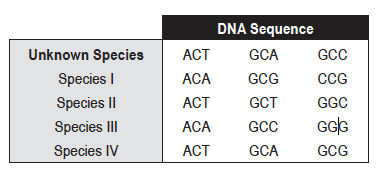
According to the data above, the unknown bacteria are most closely related to which species?
- Species I
- Species II
- Species III
- Species IV
Cell Membrane
Use the figure of a cell membrane below to answer the following:
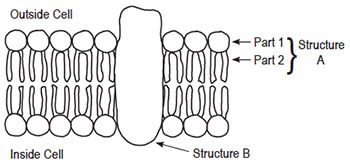
What kind of molecule is Structure A?
- an amino acid
- a phospholipid
- a carbohydrate
- a nucleic acid
Distribution Of Rabbit Fur Color
Individuals within a population of rabbits have different colors of fur as shown in the diagram below.
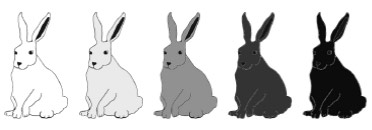
The difference in the fur color of the individual rabbits is described as:
- speciation
- variation
- evolution
- succession
Anatomy of a Squid
Squid are marine animals that have a complete circulatory system and reproduce sexually. A diagram of a squid is shown below.
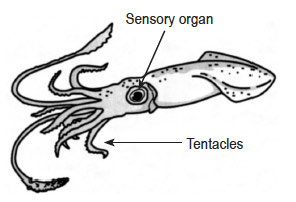
Which of these is not a purpose of a squid’s sensory organs?
- finding mates
- avoiding predators
- locating prey
- excreting waste
DNA
One kind of chromosomal mutation can occur during meiosis when a pair of chromosomes that carry genes for the same trait fail to separate. Which of these represents the sex chromosomes of a male organism when this type of chromosomal mutation has occurred?
- XXY
- XX
- XY
- XXX
Use the diagram below to answer the question.
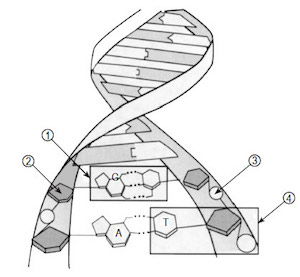
Which of these is a nucleotide?
- 1
- 2
- 3
- 4
One parent is homozygous dominant for brown hair (BB). The other parent is heterozygous for brown hair (Bb).
What is the probability that the offspring will have brown hair?
- 100%
- 75%
- 50%
- 25%
Bacteria
Evidence suggests that bacteria supplied with a cup of sugar could run a 60-watt light bulb for 17 hours.
Which of these was most likely used to affirm this scientific idea?
- formulate a hypothesis
- identify the problem
- conduct an experiment
- write a conclusion
Most bacteria do not have the ability to break down oil that is accidentally spilled into the ocean by tankers. However, scientists can insert a gene into the DNA of a bacterium to give it the ability to break down the oil. This technology is an example of
- crossing-over
- DNA replication
- gene splicing
- translation
Insects
Some adult insects are unable to swim but are able to walk on top of water. What characteristic of water enables these insects to walk on top of water?
- pH
- surface tension
- solvent properties
- atomic bonds
Plant Growth Rates
A group of students conducted an experiment to study the growth of bean plants. An equal number of bean plants of similar size were planted in containers A and B. Each day for five days, Container A received water only, while Container B received an equal amount of weak fertilizer solution. The table below shows the average height of the plants in each container for each day of the experiment.
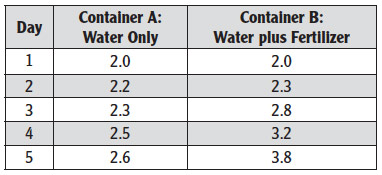
Which of these is being tested in this experiment?
- effect of water on plant height
- effect of fertilizer on plant height
- maximum height the plants will grow
- number of days the plants will grow
Sample Technical Passage With Selected Response
Use the technical passage, Scientists Explore an Aspect of Fish Migration, to answer the question below:
Scientists Explore an Aspect of Fish Migration
Toxic pollutants from agriculture and industry have been found worldwide, even in areas that are far from pollution sources. Until now, scientists have blamed air currents for spreading toxins far from their sources. However, a recent study indicates that fish can transport toxins over long distances.
Scientists developed this hypothesis when toxins were mysteriously found in a remote lake in Sweden. A team of scientists from Lund University hypothesized that salmon accumulated and stored toxins in their fatty tissues when they were in the Baltic Sea. The salmon migrated upstream, spawned and then died in the lake, releasing toxins as their bodies decomposed.
To test this hypothesis, the scientists traveled to Alaska, where they carried out an experiment in two neighboring lakes, Lower Fish Lake and Round Tangle Lake. Lower Fish Lake is open to migrating salmon, while Round Tangle Lake is closed to migrating salmon because of numerous waterfalls and rapids. A small fish, the arctic grayling, lives in both lakes. Fish eggs are a large part of its diet. When the scientists examined the arctic grayling from both lakes, the arctic grayling in Lower Fish Lake had more than twice the concentration of toxins in their bodies as the arctic grayling in Round Tangle Lake. Since both lakes are exposed to similar levels of air pollution, the difference in toxin levels found in the arctic grayling must be due to other factors.
In a related experiment, scientists caught salmon throughout their migration and tested their fatty tissues for toxins. Even though the fatty tissue deposits were gradually used up, toxin levels remained about the same throughout the 400-kilometer journey up the Copper River from the Gulf of Alaska to Lower Fish Lake. Instead of metabolizing the toxins, the salmon stored them in other body tissues that also contain fat, and in their eggs.
Both of these studies support the hypothesis that migrating salmon can transport pollutants to new areas.
According to the passage, what question is being asked by Lund University researchers?
- What are the migrating habits of salmon in Alaska and Sweden?
- Are increasing levels of air pollution affecting salmon migration?
- What are the diets of the arctic grayling and the migrating salmon found in the two Alaskan lakes?
- Are migrating salmon responsible for transporting toxins from the sea to freshwater lakes?